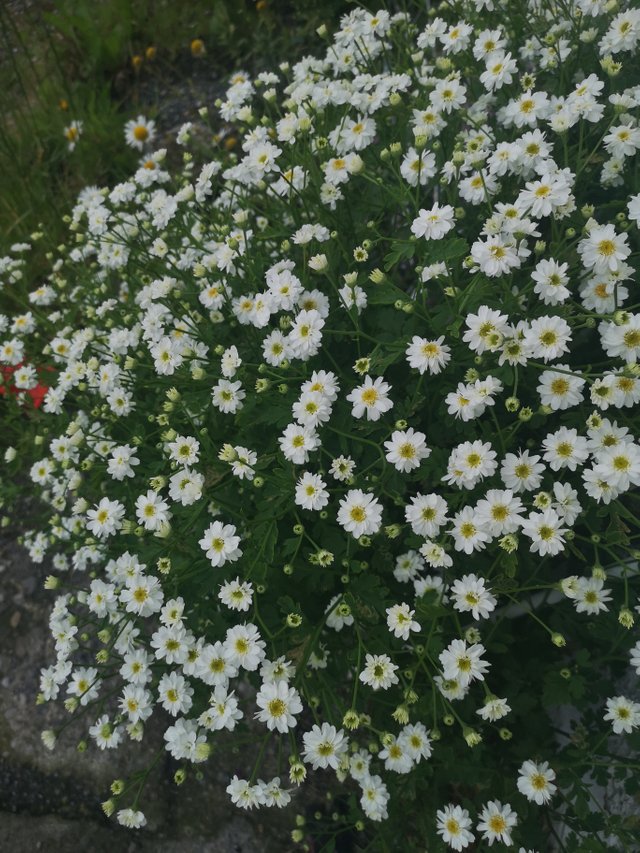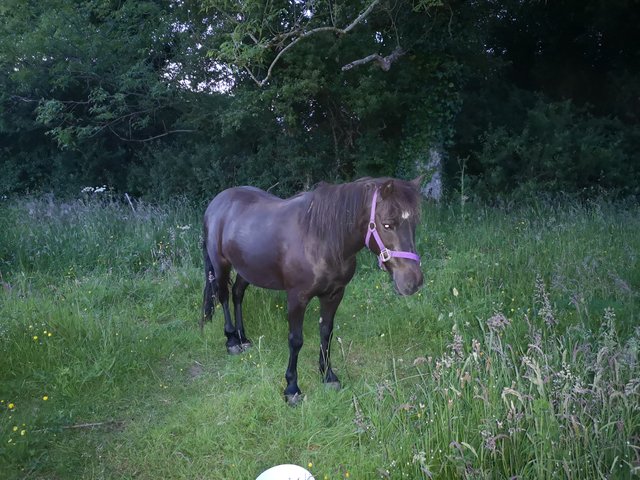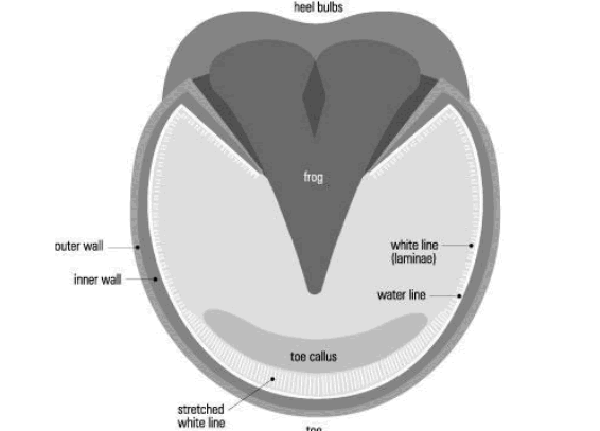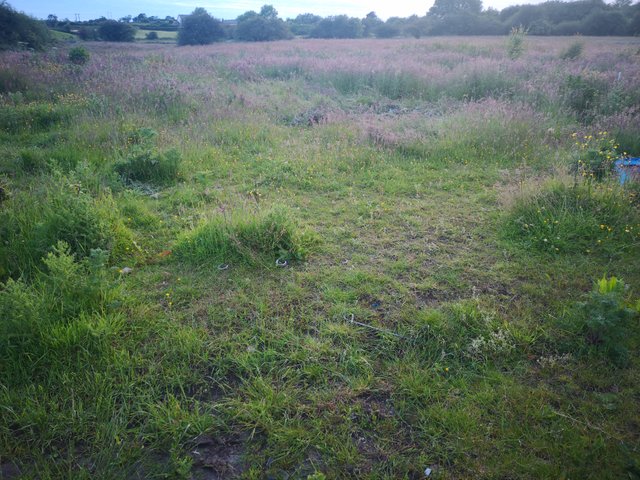How I'm treating our pony's hoof problems
It's summer, and while most people enjoy this time of the year, and all the loveliness that comes with it, for horse owners it is also a season in which they have to be more vigilant when it comes to caring for their horses and ponies.
The grass in this time of the year contains more sugars, and too much of it is one of the causes of Laminitis, a dreaded illness to any of our four-hooved friends, because it can cripple them, causes a lot of pain and it can potentially get so bad that a horse has to be put down if it's not treated right away.
What is Laminitis and what causes it?
Laminitis is a highly painful and debilitating disease which can occur in the feet of horses and ponies. Laminitis is inflammation of the sensitive structures in the hoof called the lamellae.
source
If left untreated it can cause the coffin bone inside the foot to rotate and puncture through the sole of the hoof. You can imagine, for an animal that stands and walks on those hoofs all day, this will be a very painful ordeal. Therefore, the best practice for this is to prevent this from happening altogether by keeping a close eye on the horse, and treating any signs of (beginning) laminitis right away.
So what causes laminitis?
To be honest, even veterinarian medicine is not 100% clear on that.
However, obesity and overeating can be one cause. Like I said before: the spring and early summer grass contain more sugars than hay or winter forage. A horse is always in survival mode. Our pony is a Welsh pony and in their natural habitat, they would not always have grass to eat. The land they thrive on is very rugged, contains lots of stones and only here and there a little patch of grass. Therefore, whenever they have grass, they eat and eat, because for them it's not always sure that they'll have it later on. In the winter, for instance, there will be snow, so less chance to find good food to eat. So these ponies (and others, like the Connemara ponies, and even Mustangs) will eat when they can, in the hope that they'll have enough reserves to get through the winter, or desert, in the case of Mustangs.
Another cause can be that they don't get enough exercise. Our pony's buddy died shortly after we moved to this house, and she's only had one companion for a short time since. Because of this, she walks a lot less. My daughter, whom the pony was for, to begin with, is really getting too big for her and shows little interest, so that's not much help either. My youngest would love to get going with her, but we'll have to start that slowly because our Beauty (that's the pony) doesn't trust boys because she had some bad experiences with a mean boy in a riding school in the past.
Now, I am doing as much as I can and I will play and walk with her, but there's only so much I can do.
So now we're trying to decide if we should get her a little friend, or a bigger one (for me). I am not sure about this yet, because it was my horse that died, and I'm a bit afraid to get attached to another horse. We'll have to see. Another issue is that we're not even sure if we'll be here next year, or even a few months from now, so we have to consider that too.
Right now, we're doing our best to make sure she doesn't get depressed because that can also be an additional cause of laminitis.
She's definitely not obese, and we're lucky because she'll have eating 'stops' and isn't as greedy as some other ponies or horses. This is in her favor.
However, her hooves were growing really quickly, and this can also be an indicator of laminitis or the start of it.
She didn't want to walk, or even stand most of the time, and this doesn't do it any good either.
The bare hoof farrier
I had been looking for one for a long time. In the past, we didn't really need to get a lot of work done on the horses' hooves, because when her friend Cassidy was here, they walked a lot more and naturally kept their hooves down. Now it's a different story. But I don't just want any farrier to do her hooves, because most here in Ireland are accustomed to shoed hooves, and the natural, bare hoof needs an entirely different approach.
By chance of luck (or me sending out a message into the universe) as we were driving out of the driveway of the grocery store in Castlebar the other day, I saw a van parked with on the side of it written: 'Bare Hoof Care'. I turned around and talked to the man, and got his card.
He came by to care for Beauty's hooves, and also suspected the first beginnings of laminitis.
He didn't cut her hooves back too far, as to damage them, and will come by as soon as it's needed again.
Precautions I took
Basically, our field is too big for our little pony alone. It's like serving big platters of ice cream and cake to a diabetic. It's not done. We also have the issue that the grass has grown very long. Not only grass but also nettles and thistles. In some places of the field, it comes up to my chest! So first of all, I started to cut down some of the grass and other plants. Yup, by hand with a scythe. It's hard work, but man such a fulfilling job! And a damn good work-out at the same time. After a half an hour session of that, I am sweating and my heart rate is as if I've just run two miles. I love it as much as I love cutting firewood.
Here's the first result. Do you see the long grass in the background? Yeah, I'd better get to work...🙄
A quarter of an acre done, 3 3/4 still to go...😲🙄
Meanwhile, I'm at half an acre...so tap on the shoulder to myself.
I am letting the cuttings dry, so they're easier removed.
Meanwhile, Beauty can't get to the cuttings, because that can cause even more issues.
I am zoning off half an acre with short grass, and that has to be her diet for now.
I've even played with the thought of renting out the remainder of the field to horse owners because that would solve the loneliness issue without me having to get another horse. But I'm still thinking about it because I don't really want to be responsible for other people's horses either. (to be continued)
The best for last: how I treated Beauty's beginning laminitis
The farrier told me that it could take months or even years to heal the horse completely, and she'd always be prone to laminitis.
By keeping her on this minimal diet, I could keep things at bay.
Of course, stubborn little me doesn't just sit back and wait for that to happen.
So I started searching online.
I figured, some herbs and spices have anti-inflammation properties, so I searched if these could be used for horses as well.
This is what I came up with:
Turmeric
Turmeric has very strong anti-inflammation properties and is safe for horses. It works best when we add a little black pepper, which, surprisingly, is also safe.
The farrier mentioned willow bark, as natural pain relief. However, there is no willow in our area, so I had to find something else.
Then, I remembered something. The plant with white flowers that stuck up their heads last year, were growing in huge amounts right beside our front door. A friend told me they were weeds and asked if he should remove them, but I left them because the flowers were so pretty. I pulled them out of the ground once the flowers had died down and the plant had withered.
But this year, they're back. Turns out: they're
Feverfew

The feverfew plant, literally outside our door. What a life-saver!
This plant is really amazing. Also anti-inflammation properties on this one. The feverfew has been used in natural medicine for pain, especially (migraine) headaches and, you guessed it: fever.
I've actually made a bunch of the leaves into a salve, and also made butter with it as an ingredient. Stuck it in the freezer, and ready to go if one of us comes down with a fever or headache. I will share the recipe in another post.
The leaves can be eaten raw, but they taste really, really bad... This guy in this video I saw explained it like this:
"It tastes a lot like the bitter in a gin and tonic, but also like cat litter tray." YUP, he's on point, because that was exactly my experience when I tasted it.
Anyway, I used the salve to put it on and under her hoof. Of course, it won't stay on long, but it's better than nothing.
I cut up some of the leaves, added the turmeric and black pepper and you will not believe this: mixed this together with double cream! Double cream? Yup...exactly that. I read somewhere that it relieves some of the pain with laminitis. I haven't got a clue why or how, but I was willing to try it.
(double cream is extra heavy cream, extra fat).
So I blended those four ingredients and fed it to her with a few oats. Oats also have sugars, but there was no other way she would eat it.
The result
- Day 1: the day after this treatment, Beauty still wasn't walking much, and when she did, she was visibly in pain.
- Day 2: I walked up to her with the dog, because they like each others company, but he was a bit too wild and she quickly moved away into the other part of the field. This showed me that she was getting better! She walked normal!
- Day 3: She moves from one part of the field to the other and whenever I check on her, I never find her in the same spot. This was very different before, as she just wouldn't move more than 10 steps.
- Day 4: There are NO signs that she's in pain. She's behaving like she always was, and comes when I call her. A week ago, I couldn't get her to move for anything. She seems like her happy old self again.
This is really quite something. Something that the farrier said could take months, or even longer, seems to have gotten better, if not cured within days with four simple ingredients and one simple adjustment. This is amazing!
Of course, I can't promise it will work for every horse, and we were lucky we caught it on time. But still: amazing results!
Conclusion
My kids are homeschooled (unschooled), not vaccinated and we've never even touched an antibiotic, so for us, it is only the logical next step to treat our animals the same way for as far this is possible.
We practice natural horsemanship, so the horse(s) have never had a heavy saddle on their backs, we don't ever use spurs or whips and we don't use a bit of any kind. If I don't want to treat my kids in an authoritative way, I don't do it for the horses either.
Horses will truly be your best friend if you treat them with respect, not with a whip.
So when our beloved Beauty has some issue, we try to treat it naturally as well. In nature, they know exactly what to do.
They know how to get rid of parasites (thistle flowers!, and sand), they know how to keep their hooves short (natural soil, grass) but since their environment here is not always natural, problems can arise. Like this one. But isn't it great that we can treat even laminitis naturally, with things we already have or are easy to get? I'm going to keep giving her her 'medicine' until I know for sure that she has no more issues. Other than that, she's on a short grass diet...😂 Life can be simple if you don't make it complicated.









What a gorgeous, informative and practical post! But ALL THE WAY THROUGH my heart kept asking and asking.... "What happens to Beauty when you leave?" I also cut grass at the moment with a scythe... LOL... yes it IS quite the workout!
Leading the curation trail for both @ecotrain & @eco-alex.
Together We’re Making This World A Better Place.
Click Here To Join the manually curated trail "@artemislives" to support quality eco-green content.
@ecoTrain
Well, this time we'll only be gone for three months and I found a house/petsitter who also has experience with horses. When we go for good, it depends where we're going, but there are a few natural horsemanship people here in Ireland that would probably love to have her. Either way, she's not just going to be forgotten or 'dumped'. I'd never just give her to just anyone, it has to be someone I know to take care of her and love her.
Hope your pony is okay :) I love your attitude about life and this view about not treating animals (or children!) authoritatively - pity not more people think like that.
Sounds like a real nasty disease :/ And I am at present fascinated there's an actual coffin bone:D
Yes, I have yet to figure out why they call it a coffin bone LOL. And yes, it's a really nasty illness and unfortunately, a lot of people miss it or catch on too late as it can take months or even years to develop into something incurable. Personally, I thought she already had it quite badly, but we seemed to have caught it in time and she's doing great now.
I had to learn a lot since I started on the radical unschooling journey, and am still learning, but I realized that treating each other with respect gets more done than anything else. Natural horsemanship is a beautiful thing. If you look it up on YouTube or something, you'll see how beautifully horses respond to their owners if they're treated respectfully. It first became more public with the movie 'The horse whisperer' and when I saw that, I was sold! I always knew there was a better way, I already didn't use spurs or whips with horses, and detested others for doing so. After reading books about it and doing a course on it, I learned so much about horse behaviour. All we need to do really is to understand them, and so much can be done from there without force.
You’ve been visited by @vibesforlife on behalf of Natural Medicine!
Aww, I love horses and I fancy them, I never had one of my own, just see them in hills, get a hug and ride them by paying money to the owner. Though, I had no idea, taking care of those lovely horses is a big sensitive deal. Thank you for sharing this amazing insightful post.
Consider supporting Natural Medicine through continued use of the #naturalmedicine tag, or delegating any amount through clicking below. We're all for empowerment through natural wisdoms, and love to support those on their healing journey. Come join us on Discord if you're not already there! We'd love to have you!
50SPII50SPII100SPII200II500SP
Thank you @vibesforlife! Yes, their hooves are the most important for them, so they need the care. However, if treated as naturally as possible, and not in the 'human kind of way' we get the best results I believe. Horses shouldn't be in a stable, but outside where they can move. It suits their natural way better. Us humans started to treat animals in a way they don't need to be treated. We feel sorry for them when it's cold, raining or snowing, when in reality, they don't mind it. I used to give our horses the option to go indoors by keeping the stable doors open, and guess what? They choose to stand outside in all weather. And if you've ever stood inside a stable during rain, or wind, you know why...
To listen to the audio version of this article click on the play image.

Brought to you by @tts. If you find it useful please consider upvoting this reply.
Hi @misslasvegas!
Your post was upvoted by @steem-ua, new Steem dApp, using UserAuthority for algorithmic post curation!
Your UA account score is currently 4.774 which ranks you at #1582 across all Steem accounts.
Your rank has dropped 162 places in the last three days (old rank 1420).
In our last Algorithmic Curation Round, consisting of 212 contributions, your post is ranked at #70.
Evaluation of your UA score:
Feel free to join our @steem-ua Discord server
Hi, @misslasvegas!
You just got a 0.25% upvote from SteemPlus!
To get higher upvotes, earn more SteemPlus Points (SPP). On your Steemit wallet, check your SPP balance and click on "How to earn SPP?" to find out all the ways to earn.
If you're not using SteemPlus yet, please check our last posts in here to see the many ways in which SteemPlus can improve your Steem experience on Steemit and Busy.
Congratulations @misslasvegas! You have completed the following achievement on the Steem blockchain and have been rewarded with new badge(s) :
You can view your badges on your Steem Board and compare to others on the Steem Ranking
If you no longer want to receive notifications, reply to this comment with the word
STOPVote for @Steemitboard as a witness to get one more award and increased upvotes!
I absolutely LOVE how when a problem arises the answer is usually close to hand. For me this week it was a niggly return of a UTI and not a moment later finding cleavers, which are rare around me. I do need to plant feverfew again...
Really cool you found a possible cure for your pony! Really enjoyed this post.
Posted using Partiko Android
The feverfew here came up like weeds, and to be honest, I didn't think much of them in the beginning, only that the flowers were pretty and it smelled nice. I pulled them out after the leaves had turned brown, but they regrew the next year and this year even more! I'm so glad they 'decided' to grow right next to the door here :)